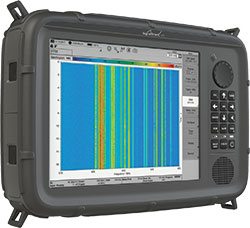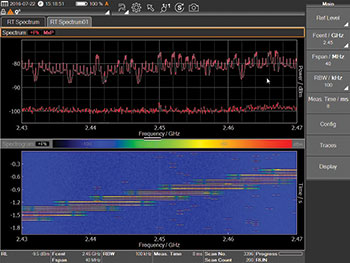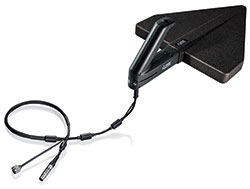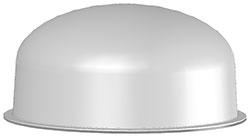
In light of the rapid development in new technologies, such as the Internet of Things (IoT), machine-to-machine (M2M) and car-to-car (C2C) communications, together with expanding 4G/5G mobile networks, increasing numbers of devices have to share the available frequency ranges. Therefore, Narda has developed the SignalShark real-time handheld analyzer to provide comprehensive measurement solutions for the increasingly complex RF spectrum. Applications include, making a wideband measurement of an entire frequency range, detecting hidden signals, reliably capturing very short impulses and localizing interference signals.
Designed for the measurement of RF signals between 9 kHz and 8 GHz, the analyzer features a sweep rate of up to 40 GHz/s, a 40 MHz real-time instantaneous bandwidth, powerful, live persistence spectrum to find hidden signals, fully automatic direction finding (DF) and a high dynamic range receiver. It is applicable for mobile and stationary use.
Its 40 MHz real-time bandwidth captures the spectrum of even very short pulsed signals of > 3.125 μs with a probability of intercept (POI) of 100 percent. This guarantees a consistent awareness of all spectrum events. Due to its distinguished analysis functions like real-time spectrum, spectrogram, persistence and channel analysis and its large integrated I/Q recorder, measured signals are analyzed with a very high frequency and time resolution. Figure 1 shows a 40 MHz real-time bandwidth (RTBW) spectrum and spectrogram–Bluetooth and Wi-Fi.

Figure 1 40 MHz RTBW spectrum and spectrogram, showing Bluetooth and Wi-Fi.
SignalShark supports manual bearing with Narda’s directional antennas (shown in Figure 2) as well as fully automatic DF in combination with the company’s automatic DF antennas (see Figure 3). A live map view shows the current position, bearings and localizations.
OPERATING MODES & TASKS
The SignalShark has two basic operating modes. The scan mode supports the measurement of the spectrum with a full frequency span of 9 kHz up to 8 GHz within one measurement and a maximum measurement speed of 40 GHz/s, while the real-time fixed frequency mode enables real-time spectrum measurements with a frequency span of up to 40 MHz.
This frequency span will be acquired simultaneously in frequency and also gapless in time with 75 percent of overlapping of the fast Fourier transform (FFT) frames. For frequency spans ≤ 20 MHz, the overlapping of the FFT frames increases to 87.5 percent. At the same time, a second digital downconverter is used to analyze and demodulate the I/Q data of a separate channel with selectable frequency and bandwidth within the 40 MHz real-time bandwidth.
Also, predefined measurement tasks are stored in the analyzer in advance, facilitating consistent, effective and reliable measurements for both beginners and experts alike. Measurement tasks are represented by a tab on the 10.4 inch touch screen, like a website within a web browser. Users can add up to six measurement visualizations (Views) to a task, to adapt it to specific user needs. SignalShark is supplied with several predefined tasks, so users can immediately begin making measurements.

Figure 2 SignalShark manual directional antenna.
VIEWS
Measurements are visualized within different kinds of views. The frequency domain and time domain can be examined at the same time, for example, by adding a spectrum view and a high time resolution (HTR) Magnitude view to a measurement task. The individual views are:
- Spectrum (scanned or real-time) shows level over frequency.
- Peak Table (of spectrum) provides a list of relevant signal peaks in the measured spectrum.
- Spectrogram offers a visual representation of recorded spectra over time with colors representing the signal level. The smallest selectable time resolution is 31.25 μs and detectors are used to compress the high speed real-time spectra to the selected time resolution.
- Level Meter (& Compass) shows the channel level as a bar graph and compass values.
- I/Q (versus time) displays the measurement data as I (in-phase demodulated signal) and Q (quadrature demodulated signal) components versus time for determining modulation type and interference.
- HTR Magnitude displays signal power versus time.
- HTR Spectrogram displays signal as a spectrogram with an arbitrary high time resolution. Colors represent the signal level.
- Persistence (of real-time spectrum) displays spectra as level versus frequency. Sporadic signals are detected easily and color indicates the rate of occurrence.
- Bearing (& Level Meter) shows azimuth and level of an automatic DF antenna.
- Horizontal Scan shows the signal level over azimuth angle in a polar diagram.
- Map view visualizes the current position, bearings, located transmitters and selectable measurement data within a geographical map.
Note: I/Q, HTR Magnitude, HTR Spectrogram and Horizontal Scan will be available in a later firmware version.

Figure 3 SignalShark automatic direction finding antenna.
AUTOMATIC DF ANTENNAS
Another significant feature is that SignalShark can be connected to an automatic DF antenna, which translates signals from several antenna segments into a single channel DF signal. The antenna is controlled by the analyzer, which automatically calculates bearings out of the single channel DF signal.
The antenna can be mounted to an antenna mast or can be attached to the rooftop of a vehicle via a magnetic mount adapter. The measurement results contain bearings, as well as omnidirectional level and spectrum values. In its omnidirectional mode, the antenna can be used for real-time measurements too.
40 MHz REAL-TIME BANDWIDTH (RTBW)
The SignalShark’s ability to make powerful real-time measurements with a real-time bandwidth of 40 MHz in a handheld design will not only help accelerate the development of mobile technologies within the industry, it will also assist mobile service providers and authorities to ensure interference free networks and support regulators in providing protection from illegal transmitters and hidden signals.
Narda Safety Test Solutions
Pfullingen, Germany
+49 7121 9732-0
www.narda-sts.com
